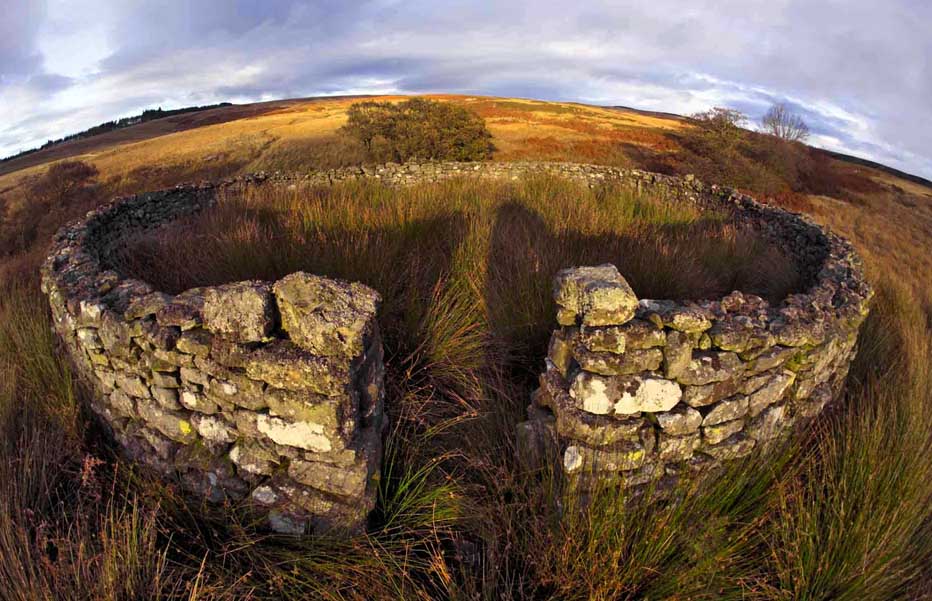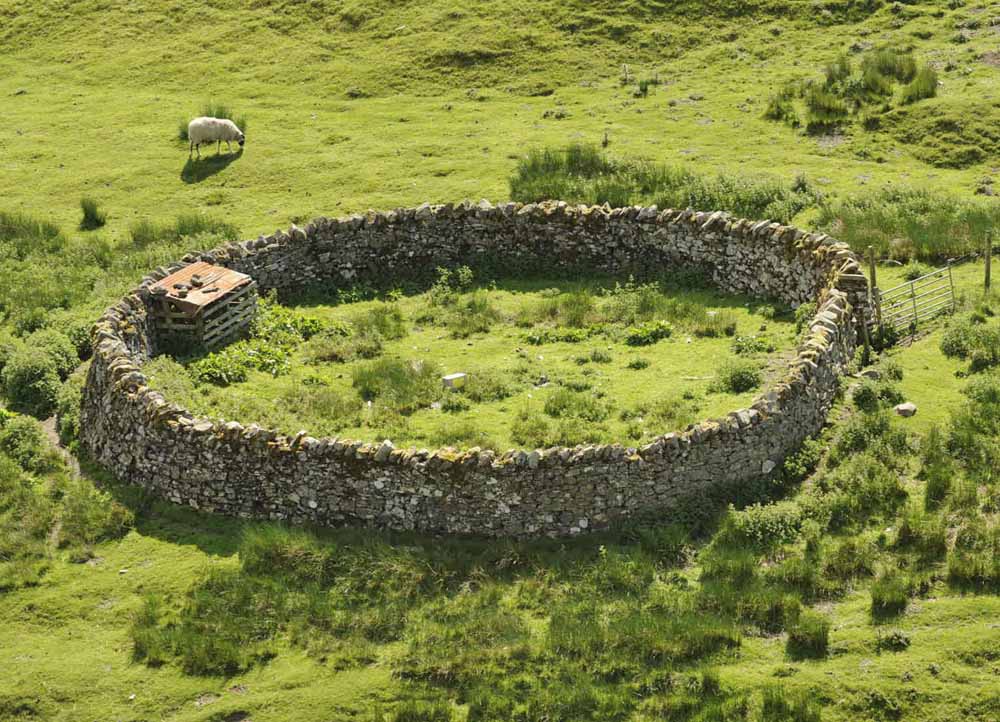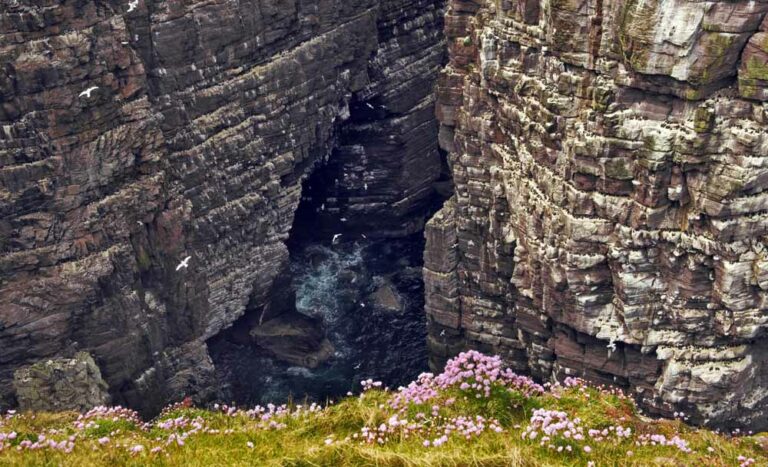From above, the sheep stell looked like a button on a jumper, sewn into the contours of the slope. Its neat, circular form lay nestled on the lower ground, with the open spread of the hill around it. As a manmade structure lying far beyond fields and stone walls, it stood out in the landscape . Sheep paths wound up and down to it, scored into the peat like fine capilliaries and blood vessels criss-crossing the land.
These circular, stone walled enclosures are common in the Border hills, offering shelter to sheep and cattle from storms and winter weather. Sometimes found on high ground, stells were designed to deflect snow and prevent it from drifting and were therefore placed in spots where snow would struggle to settle, on ridges and knolls, or between gullies and rivers. They are traditional places of vital shelter from the elements for shepherd and flock, constructions of mitigation and retreat.
Stells, or “rounds” as they were sometimes called, were said to be introduced to the Southern Uplands after severe storms in 1620. The word “stell” appears in the Scottish National Dictionary as a verb meaning to “place in position, to set up, fix, plant, prop, mount.” The dictionary also includes the word “stell” to refer to places in the riverbed, where nets were drawn to catch sheltering salmon. A document dating back to 1707 describes stells as “deep ponds, pools and ditches in the river, where the salmon haunting are taken in nets spread beneath them.”
I have always been fascinated by these structures when I come across them in the wild, open spaces of the Northumbrian hills. Like a Celtic brooch clasped to the land, a stell is aesthetically pleasing in shape, the stone work often tightly executed to form a perfect round with an opening, to allow the free passage of animals in and out. Seen from afar, their small presence on remote ground demonstrates the need for places of gathering, protection and security, to create essential shelter and withstand harsh conditions. In the weather, but out of the weather.
Perhaps it is this intentional space that captures my imagination – a recognition of our own need for space in the mind for safety, shelter and renewal. And the possibility of being inwardly gathered and collected amidst the changing landscapes and vicissitudes of life, a place where it is possible to separate from storms and confusion, and where we can experience reinforcement and peace.
Perhaps their circular form also represents something archetypal about shelter. Traditional places of shelter are often circular; igloos, yurts, mountain cairns, ancient brochs and hut circles, all point to the most efficient use of materials and structure to offer containment, collectedness and safety. In nature, the circle provides the woven proficiency of a bird’s nest for cradling its eggs, and the honeycombs of wild bees hang in rounds for gathering and storing honey.

I find the image of a stell helpful for recognising those needed moments of spaciousness in the day, to encircle time for quiet, a purposeful place of calming and resourcing. A stell of the mind, where attention can be gathered, settled and collected, in the midst of the ups and downs of daily life. A place that supports practice to support life itself. In the weather, but out of the weather.
I’m not talking about anything complicated. It just means taking simple moments at the start or end of the day, or making time for a walk or quiet reflection, pausing mid-activity if needed, to consider what is most essential and to bring body, heart and mind quietly together again with renewed attention and vitality. The possibility of such gathering places in the day depends upon recognizing a need for quiet space in the first place, and being willing to create it.
Whereas the value of a stell on an open fell seems so practically essential, offering ourselves an internal equivalent is a basic need which can be easily overridden by habit, perceived constraints of time and pressures on our attention from media in all its forms. We talk about “gathering our wits” and yet these internal spaces are always possible within our busyness, if we intentionally make and find time for gathering and collecting the scattered mind.
My personal stell is portable. It comes with me wherever I go and I can step into it at any time. I am both verb and noun. I “place it in position, set it up, fix it, plant it, prop and mount it”, whenever I need it. I increasingly recognize that it comes down to a relationship with my own mind. I know when I need to draw a circle around time for personal space and reflection, and to drink from the waters of creativity. It’s sheltered ground where the natural space of the mind breathes and where I feel the flux of life flow through me and around me. In the weather, but out of the weather. Like the sheltering salmon, it’s the gathered place in the river where I rest.
When I step into the stillness of the stone stell, I wonder who had laboured to bring the stone here, which hands had placed the stones and from whom the skill was learned. Who sheltered here, and how many blizzards and storms had this place withstood? What was it like in here, when the snow was blowing hard? Both human and animal presence are tangible, along with a sense of time passing. A living shelter built by those no longer alive. And yet its presence here, amidst trampled rushes, whisps of fleece caught on thistles and edges of rock, and pock-marked sheep tracks, leading to it and away from it, speak of a continuity, durability and resilience to the changing conditions of weather and time.





